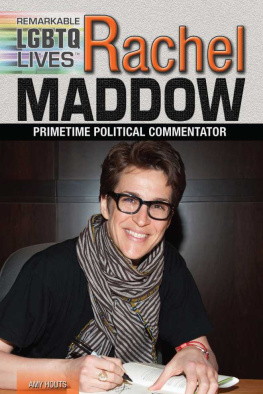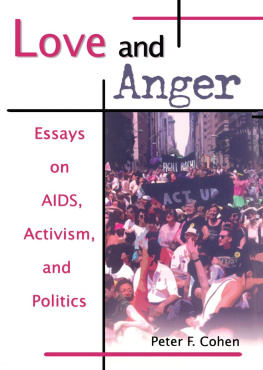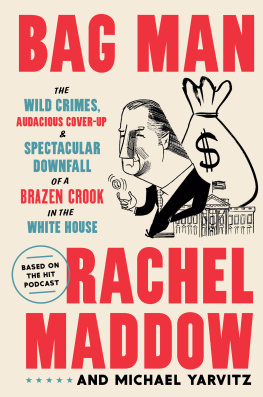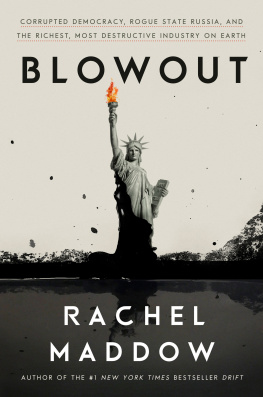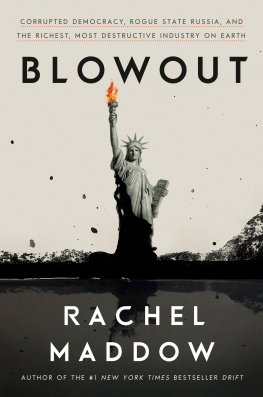Published in 2015 by The Rosen Publishing Group, Inc. 29 East 21st Street, New York, NY 10010
Copyright 2015 by The Rosen Publishing Group, Inc.
First Edition
All rights reserved. No part of this book may be reproduced in any form without permission in writing from the publisher, except by a reviewer.
Library of Congress Cataloging-in-Publication Data
Houts, Amy, 1957-
Rachel Maddow: primetime political commentator/ Amy Houts.1st edition.
p. cm.(Remarkable LGBTQ lives)
Includes bibliographical references and index.
ISBN 978-1-4777-7891-3 (library bound)
1. Maddow, RachelJuvenile literature. 2. Television personalitiesUnited StatesBiographyJuvenile literature. 3. Radio personalitiesUnited States BiographyJuvenile literature. 4. Political activists United StatesBiographyJuvenile literature. I. Title. PN1992.4.M2595H68 2014 070.92dc23 [B]
2014006860
Manufactured in the United States of America
CONTENTS
INTRODUCTION
W
atching The Rachel Maddow Show, its obvious that Rachel Maddow (whose last name rhymes with the word shadow) loves her job. Often smiling and sincerely excited about the newssomething that others often find boringMaddow breaks down complex issues into easily understandable parts. The first openly gay primetime news anchor, she has the freedom to present the topics about which she cares passionately, including LGBT (an acronym that stands for lesbian, gay, bisexual, and transgender) rights, issues surrounding AIDS and treatment, and womens rights. Other news shows do not always report on these controversial issues, but Maddow is a natural at presenting them. In fact, it seems as though Maddow was born to host her own news show, even though she didnt plan on a career in broadcasting.
Maddow grew up during the 1980s, a time when AIDS (acquired immune deficiency syndrome) was a new, unfamiliar disease that, for lack of research and treatment options, was considered to be a death sentence. In a March 2012 interview with National Public Radio (NPR), Maddow said that growing up at a time dominated by the AIDS crisis shaped her and motivated her to become an AIDS activist. For over a decade, she worked for a variety of organizations fighting for the rights of those infected with HIV (human immunodeficiency virusthe virus that causes AIDS). She fought for one of the most marginalized groups of people, those in prison who were infected with HIV. Because of the ignorance surrounding the virus, prisoners were unjustly segregated and isolated from other prisoners. At the time, Maddow thought AIDS activism would be her lifes work. Among her most prized possessions are letters that she received from friends who died of AIDS.

An elated Rachel Maddow talks about her book, Drift: The Unmooring of American Military Power, at the 2013 Philadelphia Book Festival.
In high school, Maddow felt a real connection to the AIDS movement, and she began volunteering. Looking back, she thinks her interest in the fight against AIDS arose because she was beginning to figure out that she was gay. Before fully realizing her attraction to women, Maddow dated a male marine in high school. Nonetheless, by the time she was a freshman in college, Maddow came out, making her one of two openly gay students in Stanford Universitys freshman class of one thousand. She now lives with her long-term partner, Susan Mikula.
In spite of her support of same-sex marriage rights and the fact that the pair live in Massachusetts (which became the first U.S. state to make same-sex marriage legal, in 2004), Maddow and Mikula are not married. However, according to a July 2008 article in the Nation, Maddow said her relationship with Mikula was her proudest accomplishment. She and Mikula have been together since 1999.
In a January 2009 interview with Lesley Stahl for the Women on the Web, Maddow was asked about being gay. She replied, I dont often think about whether or not people know that Im gay. I assume that everybody knows that I am. Its integral. Maddows personal life and identity have proved to be major factors in her success and passion for topics that other reporters shy away from. What makes Rachel Maddow the person she is today, and how did her career make the transition from activist to anchor? The answers lie ahead.
R achel Maddow was born on April 1, 1973, in Castro Valley, California, a conservative, middle-class community. The way of life in her hometown was quite different from the hippie counterculture for which nearby San Francisco was famous. Rachels mother, Elaine, modeled the advantages of a good education in her work as a school administrator. Her father, Robert, was a lawyer for a utility company. Her family encouraged her to help others.
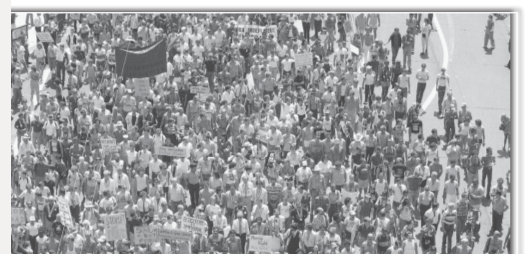
Beginning in the 1950s,people who embraced a new way of thinking that challenged traditional American values flocked to San Francisco and made way for protests, such as this one in 1984.
A SERIOUS CHILD
Rachels interest in the news started during her preschool years. A serious child, she began reading the morning newspaper at age four. Sitting on a kitchen stool still in her nightgown, she would read the paper while her mother prepared breakfast. By age seven, Rachel was asking her parents relevant questions after reading the newspaper cover to cover. That same year, she learned to ride a bicycle in one weekend without using training wheels. She was quite an advanced learner!
Rachel never used baby talk, the simplified speech many young children use while still learning how to speak. From a young age, she spoke using adult vocabulary. An articulate and vivacious speaker, communication is what would later make Rachel famous.
THE AIDS EPIDEMIC
In 1980, Ronald Reagan was elected president of the United States. Rachel remembers watching Reagan on their black-and-white TV set when he won the election. According to a November 2008 Newsweek article, Maddow recalled, All I remember is the feeling of dislike. As she studied the Reagan administrations policies further, her opposition grew. The Reagan era was marked by the beginning of the AIDS epidemic. This disease was first discovered by the Centers for Disease Control and Prevention (CDC) in 1981, and named AIDS in 1982.

Ronald Reagans wife, Nancy, looks admiringly at her husband as he is sworn in as the president of the United States. Reagan was sixty-nine years old.
Even though many Americans were dying of AIDS, President Reagan didnt mention the disease once during his first term in office. His budget also did not provide enough money for AIDS research, education, or treatment. With better funding, the number of HIV infections or the death rate from AIDS could have been significantly reduced. Because in its early days AIDS predominantly affected gay menwhich at the time, and in many ways still, was a stigmatized community many felt there was not as much interest in finding a cure for it.

